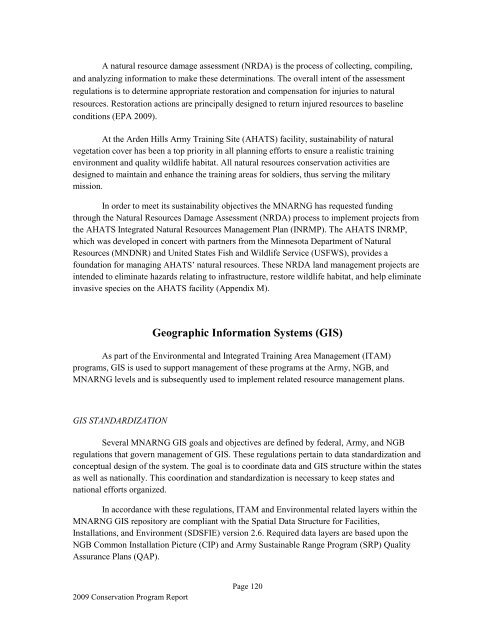camp ripley and arden hills minnesota army national guard training ...
camp ripley and arden hills minnesota army national guard training ...
camp ripley and arden hills minnesota army national guard training ...
You also want an ePaper? Increase the reach of your titles
YUMPU automatically turns print PDFs into web optimized ePapers that Google loves.
A natural resource damage assessment (NRDA) is the process of collecting, compiling,<br />
<strong>and</strong> analyzing information to make these determinations. The overall intent of the assessment<br />
regulations is to determine appropriate restoration <strong>and</strong> compensation for injuries to natural<br />
resources. Restoration actions are principally designed to return injured resources to baseline<br />
conditions (EPA 2009).<br />
At the Arden Hills Army Training Site (AHATS) facility, sustainability of natural<br />
vegetation cover has been a top priority in all planning efforts to ensure a realistic <strong>training</strong><br />
environment <strong>and</strong> quality wildlife habitat. All natural resources conservation activities are<br />
designed to maintain <strong>and</strong> enhance the <strong>training</strong> areas for soldiers, thus serving the military<br />
mission.<br />
In order to meet its sustainability objectives the MNARNG has requested funding<br />
through the Natural Resources Damage Assessment (NRDA) process to implement projects from<br />
the AHATS Integrated Natural Resources Management Plan (INRMP). The AHATS INRMP,<br />
which was developed in concert with partners from the Minnesota Department of Natural<br />
Resources (MNDNR) <strong>and</strong> United States Fish <strong>and</strong> Wildlife Service (USFWS), provides a<br />
foundation for managing AHATS‟ natural resources. These NRDA l<strong>and</strong> management projects are<br />
intended to eliminate hazards relating to infrastructure, restore wildlife habitat, <strong>and</strong> help eliminate<br />
invasive species on the AHATS facility (Appendix M).<br />
2009 Conservation Program Report<br />
Geographic Information Systems (GIS)<br />
As part of the Environmental <strong>and</strong> Integrated Training Area Management (ITAM)<br />
programs, GIS is used to support management of these programs at the Army, NGB, <strong>and</strong><br />
MNARNG levels <strong>and</strong> is subsequently used to implement related resource management plans.<br />
GIS STANDARDIZATION<br />
Several MNARNG GIS goals <strong>and</strong> objectives are defined by federal, Army, <strong>and</strong> NGB<br />
regulations that govern management of GIS. These regulations pertain to data st<strong>and</strong>ardization <strong>and</strong><br />
conceptual design of the system. The goal is to coordinate data <strong>and</strong> GIS structure within the states<br />
as well as <strong>national</strong>ly. This coordination <strong>and</strong> st<strong>and</strong>ardization is necessary to keep states <strong>and</strong><br />
<strong>national</strong> efforts organized.<br />
In accordance with these regulations, ITAM <strong>and</strong> Environmental related layers within the<br />
MNARNG GIS repository are compliant with the Spatial Data Structure for Facilities,<br />
Installations, <strong>and</strong> Environment (SDSFIE) version 2.6. Required data layers are based upon the<br />
NGB Common Installation Picture (CIP) <strong>and</strong> Army Sustainable Range Program (SRP) Quality<br />
Assurance Plans (QAP).<br />
Page 120
















